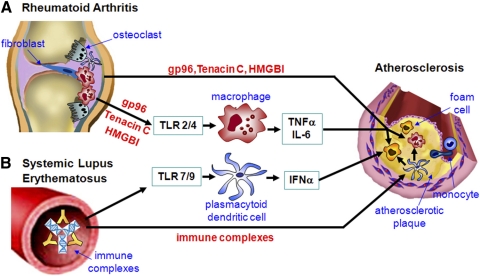Figure 1.
The connection between autoimmunity and atherosclerosis. The association of atherosclerosis with endogenous ligands mediated TLR signaling in RA or immune complex mediated TLR signaling in SLE is outlined in this figure. (A) Endogenous gp96, Tenacin C or HMGBI released from the inflamed synovial tissue of RA serve as TLR ligands to active macrophages and foam cells accumulated in the atherosclerotic plague. This activation is promoted by the inflammatory cytokines (such as TNFα and IL-6) from the rheumatoid joint mediated by macrophages, resulted in the increased occurrence and severity of atherosclerosis in patients with RA. (B) In SLE, the endogenous immune complexes, formed by anti RNA and DNA antibodies, active plasmacytoid dendritic cells mediated by TLR7 and TLR9 to release IFNα. The systemic release of IFNα further promotes the activation of macrophages and foam cells in the atherosclerotic plaques. In addition, the plasmacytoid dendritic in the plaque can be activated by direct contact with the RNA/DNA containing immune complexes, further inducing the local recruitment and activation of inflammatory cells, resulting in a self-perpetuating process of inflammation and plaque formation towards rupture.

